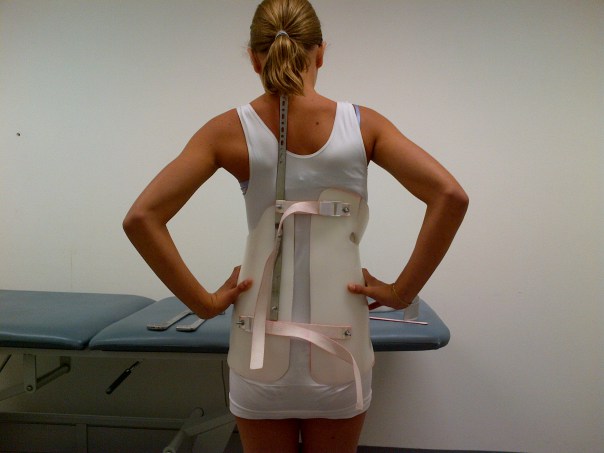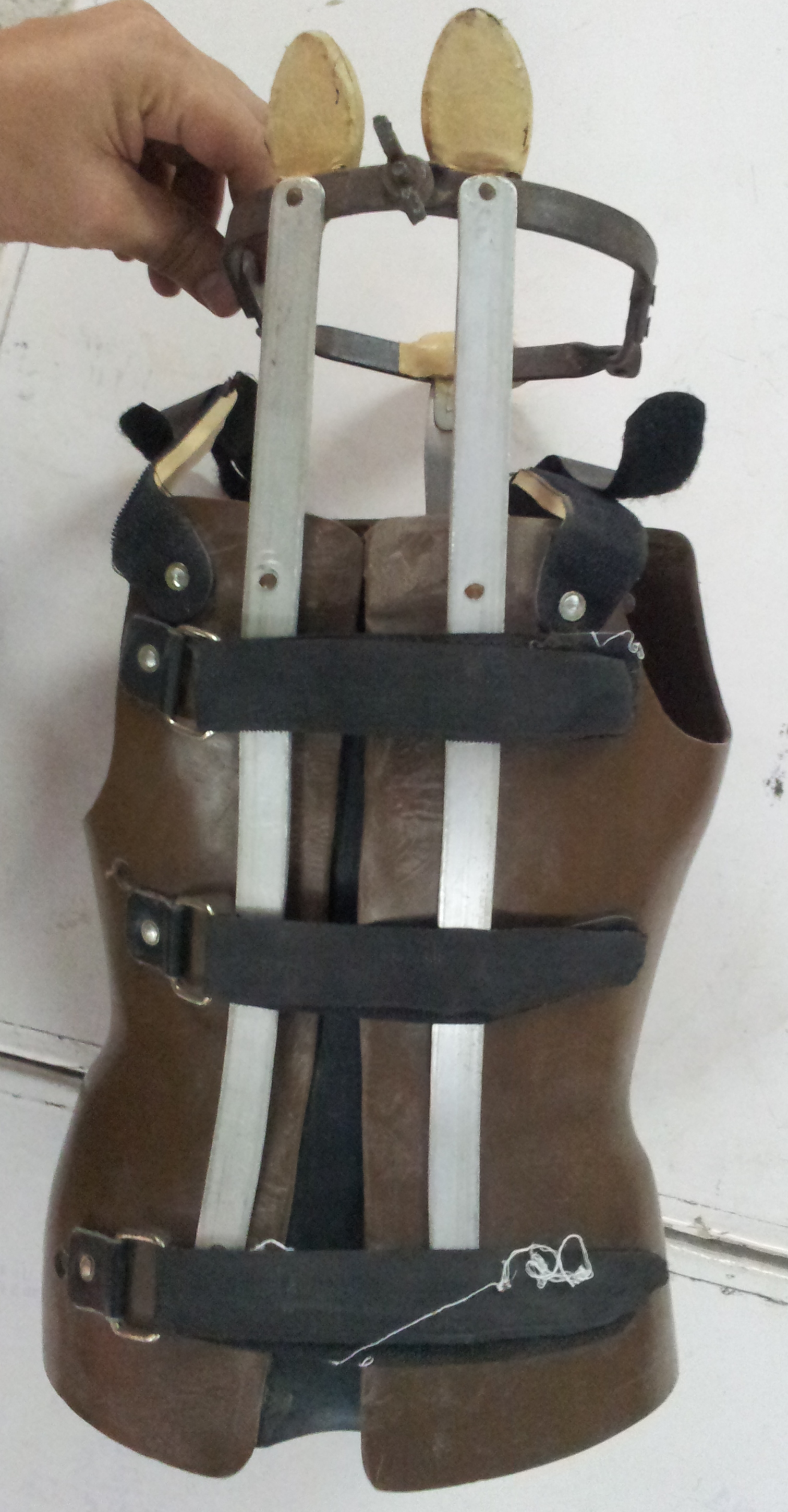Scoliosis medical therapy
Jump to navigation
Jump to search
|
Scoliosis Microchapters |
|
Diagnosis |
|---|
|
Treatment |
|
Case Studies |
|
Scoliosis medical therapy On the Web |
|
American Roentgen Ray Society Images of Scoliosis medical therapy |
|
Risk calculators and risk factors for Scoliosis medical therapy |
Editor-In-Chief: C. Michael Gibson, M.S., M.D. [1]; Associate Editor(s)-in-Chief: Rohan A. Bhimani, M.B.B.S., D.N.B., M.Ch.[2]
Overview
The traditional medical management of scoliosis is complex and is determined by the severity of the curvature, skeletal maturity, which together help predict the likelihood of progression.
Medical Therapy
- The treatment of scoliosis is based on the type of scoliosis, the magnitude of the curve, the number of years of growth remaining and the patient’s opinion about the shape of their back.
- The treatment options include:[1][2][3]
- Typically, observation is recommended for immature patients with curves of less than 25°.
- Orthotic management with brace is recommended for immature patients with progressing curves between 25° and 50°.
- Surgical correction of idiopathic scoliosis is considered for curves greater than 45° in immature patients and for curves greater than 50° in mature patients.
- The trunk deformity and balance is also included in the decision-making process.
Bracing
 |
- Bracing is commonly prescribed to prevent progression of the spinal curvature in adolescents.[4]
- There are several types of braces depending on the individual's condition and type of curve.
- Bracing is only done when the patient has bone growth remaining, and is generally implemented in order to hold the curve and prevent it from progressing to the point where surgery is necessary.
- Bracing involves fitting the patient with a device that covers the torso and in some cases it extends to the neck.
- The most commonly used brace is a TLSO, a corset-like appliance that fits from armpits to hips and is custom-made from plastic. It is usually worn 23 hours a day and applies pressure on the curves in the spine.
- The amount of time an adolescent has to wear a brace each day can range from sixteen hours a day to twenty-three hours a day, depending on the patient. A recent study shows that there is no significant difference between these two time ranges.
- Adolescent patients can be required to wear the brace for as long as five years, and generally lasts until his or her growth spurt has completed. Braces are not always effective, however, and patients may require surgery even after being braced.
- Bracing is only mildly effective as compliance is typically low, although some of the newer braces (such as the Charleston back brace) are touting better compliance rates and outcomes.
- Typically braces are only used for idiopathic curves that are not grave enough to warrant surgery, but they may also be used to prevent the progression of more severe curves in young children, in order to buy the child time to grow before performing surgery which would prevent further growth in the part of the spine affected.
- In infantile, and sometimes juvenile scoliosis, a body cast or plaster jacket may be used instead of a brace. It has been proven possible to permanently correct some cases of infantile idiopathic scoliosis by using a series of plaster body casts applied under corrective traction, which help to "mould" the infant's soft bones and work with their infantile growth spurts. This method was pioneered by UK scoliosis specialist Min Mehta.
- Compliance and wearing time also seems to have a role in the efficacy of bracing.
- Bracing, however, does not permanently improve or correct the curve but tries to prevent it from worsening.
Boston Brace
- Boston Brace is a type of Thoraco-Lumbo-Sacral-Orthosis (TLSO), that fits around the patient's body like a jacket and is customized.[5]
- The Boston brace is recommended for correcting curves in the lumbar or thoraco-lumbar area of the spine.
- Design:
 |
Milwaukee Brace
- Milwaukee brace is a type of Cervico-Thoraco-Lumbo-Sacral-Orthosis.
- Milwaukee brace's features are different from a Boston Brace, include large metal bars that extend around the shoulders to help against spine curvature.
- Design:
- Three bars—two posterior and one anterior—are attached to a pelvic girdle made of leather or plastic, as well as a neck ring.
- The ring has an anterior throat mold and two posterior occipital pads, which fit behind the patient's head.
- Lateral pads are strapped to the bars; adjustment of these straps holds the spine in alignment.
Charleston Bending Brace
- Charleston bending brace, is molded to work when the patient is lying on their side. [6]
- It is only used as a night brace.
- The brace work against the body's curve by over-correcting.
- It is used for single thoraco-lumbar curves.
SpineCor
- There is also a new type of brace which attempts to improve quality of wearer's life by allowing freedom of movement and improved cosmesis.[7]
- SpineCor brace is a non-rigid brace which is applied according to the curve specific corrective movement principle and aims neuromuscular re-education of the body.
- Spinecor has proved to be equally matched to TLSO brace in terms of success rate and surgery rate.
- Howerever, on Scoliosis Research Society - 22 (SRS -22) questionnaire for quality of life, SpineCor brace was found to be better than TLSO in terms of pain, self-image and function/activity.
Physical Therapy
- Chiropractic and physical therapy have some degree of anecdotal success in treating scoliosis that is primarily neuromuscular in nature, however non-surgical approaches will not address severe bone deformities associated with many cases of scoliosis. Chiropractors utilize joint mobilization techniques and therapeutic exercise to increase a scoliosis patient's flexibility and strength, theorizing that this better enables the brace to influence the curvature of the spine. Electronic Muscle Stimulation (EMS) is another therapeutic modality commonly utilized by chiropractors and physical therapists to reduce muscle spasms and strengthen atrophied muscles.
- There is limited published scientific research to evaluate the efficiency of treatment programs that include a combination of bracing along with physical therapy. While much debate remains in the scientific community about whether or not chiropractic and physical therapy can influence scoliotic curvature, there may well be palliative benefit from them in scoliosis patients who experience back pain either directly as a result of their deformity or indirectly from wearing an uncomfortable brace for the vast majority of the day.
- A non-invasive treatment for idiopathic scoliosis used successfully in Europe since the 1920s was established in the English-speaking world in the first years of the 21st century. Originally developed in Germany by scoliosis sufferer Katharina Schroth, this method is now taught to scoliosis patients in clinics specifically devoted to Schroth therapy in Germany, Spain, England, and, most recently, the United States. Physical therapists who do not specialize exclusively in Schroth therapy but who have received Schroth certification through the clinics in Spain and Germany offer Schroth therapy throughout Europe, parts of the Middle East, and the United States.
- The Schroth method of physical therapy, combined with the Rigo-Cheneau bracing system (developed by Dr. Manuel Rigo of Spain and Dr. Jacques Cheneau of France), addresses scoliosis from a three-dimensional approach both to prevent progression of scoliotic curvature (in children) and reduce resulting pain as well as promote anatomical symmetry (in children and adults). Because each individual's curve is unique, and because scoliosis involves the rotation (twisting) of vertebrae--in different directions in different areas of the spine--as well as the side-to-side, S-shaped or C-shaped curvature, this three-dimensional approach seeks both to "untwist" (or de-rotate) and to straighten the spine by employing specialized equipment and exercises that elongate shortened muscles and strengthen overstretched, overtaxed muscles. The exercises are augmented by a technique called "rotational breathing," which expands collapsed portions of the rib cage, thus also helping to pull the spine out of its twisting and curving.
- In children with immature skeletons and remaining growth potential, Schroth-method physical therapy is used in combination with the Rigo System-Cheneau brace not only to prevent progression of (and sometimes reduce) the condition but also to train and strengthen patients in holding their bodies in as corrected a position as possible after completion of the bracing treatment (i.e., when the skeleton has reached maturity). A patient's consistent practicing of an individualized Schroth program for one-half hour per day, after an initial intensive training period of two to six weeks, has been clinically shown to inhibit the mechanical forces, exacerbated by poor postural habits and gravity, that otherwise perpetuate the progression of the curvature over time (the so-called "vicious cycle"), even after the cessation of physical growth.
References
- ↑ Nachemson AL, Peterson LE (1995). "Effectiveness of treatment with a brace in girls who have adolescent idiopathic scoliosis. A prospective, controlled study based on data from the Brace Study of the Scoliosis Research Society". J Bone Joint Surg Am. 77 (6): 815–22. PMID 7782353.
- ↑ Lovell, Wood (2014). Lovell and Winter's pediatric orthopaedics. Philadelphia: Wolters Kluwer Health/Lippincott Williams & Wilkins. ISBN 9781605478142.
- ↑ Janicki JA, Alman B (2007). "Scoliosis: Review of diagnosis and treatment". Paediatr Child Health. 12 (9): 771–6. PMC 2532872. PMID 19030463.
- ↑ Zaina F, De Mauroy JC, Grivas T, Hresko MT, Kotwizki T, Maruyama T; et al. (2014). "Bracing for scoliosis in 2014: state of the art". Eur J Phys Rehabil Med. 50 (1): 93–110. PMID 24622051.
- ↑ Willers U, Normelli H, Aaro S, Svensson O, Hedlund R (1993). "Long-term results of Boston brace treatment on vertebral rotation in idiopathic scoliosis". Spine (Phila Pa 1976). 18 (4): 432–5. PMID 8470002.
- ↑ Rowe DE, Bernstein SM, Riddick MF, Adler F, Emans JB, Gardner-Bonneau D (1997). "A meta-analysis of the efficacy of non-operative treatments for idiopathic scoliosis". J Bone Joint Surg Am. 79 (5): 664–74. PMID 9160938.
- ↑ Ersen O, Bilgic S, Koca K, Ege T, Oguz E, Bilekli AB (2016). "Difference between Spinecor brace and Thoracolumbosacral orthosis for deformity correction and quality of life in adolescent idiopathic scoliosis". Acta Orthop Belg. 82 (4): 710–714. PMID 29182110.